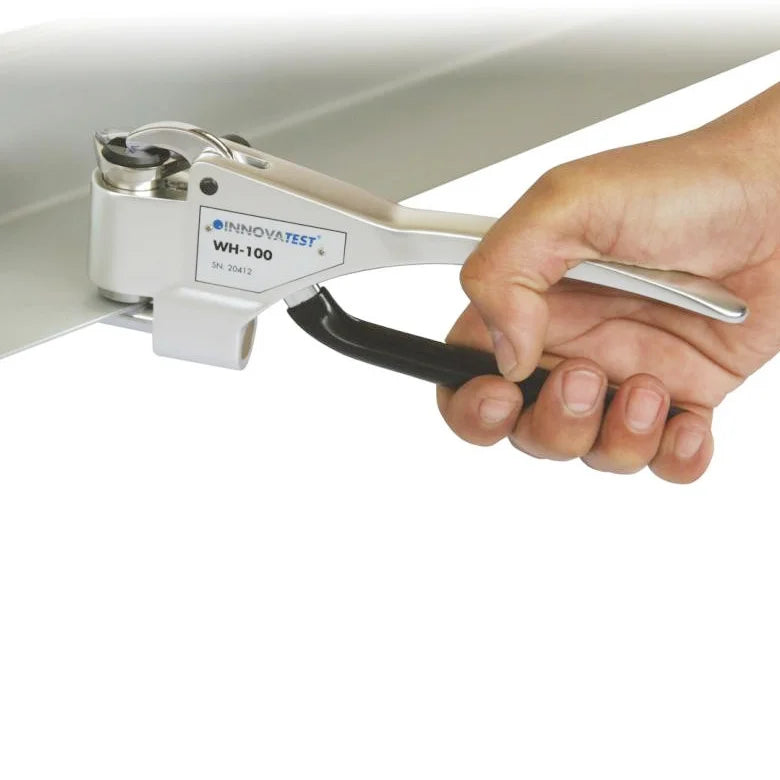The Falcon 800G2 Vickers Hardness Tester provides a wide force range, offering maximum flexibility
Introduction
Selecting the correct hardness scale is crucial for obtaining accurate, reliable, and repeatable hardness measurements. While the test method (e.g., Rockwell, Vickers, Brinell) is typically predetermined, choosing the right hardness scale ensures optimum indentation size, reducing measurement uncertainty and improving test accuracy.
This guide explains the key considerations in selecting the right hardness scale, the impact of indentation size, and common pitfalls when defining hardness values.
Importance of Choosing the Correct Hardness Testing Scale
Hardness scales are used to measure the resistance of a material to deformation. However, using an inappropriate scale can result in inconsistent or unreliable results, no matter which hardness tester you use. The correct hardness scale:
- Provides the largest possible indentation while maintaining precision
- Minimizes measurement uncertainty
- Ensures compliance with material specifications
When selecting a hardness testing scale, the goal is to achieve the largest indentation possible while adhering to the 10:1 rule.
The 10:1 Rule for Indentation
The 10:1 rule states that material or coating under test needs to be 10 times thicker than the depth of the indentation to ensure accurate results. This rule prevents material or coating thickness interference and ensures a valid measurement.

Example:
There is no need to use the HV0.1 Vickers scale if an HV10 Vickers test provides a sufficiently large indentation while adhering to the 10:1 rule.
A larger indentation reduces measurement uncertainty, leading to more consistent results.
Hardness Testing Scale Selection Based on Application
1. When the Hardness Scale is Defined on a Drawing or Specification
More often than not, the required hardness scale is specified on engineering drawings or technical specifications. However, this is not always correct.
Issue:
The specified hardness scale may not be appropriate for the material thickness.
Example: A specification may require 60HRC (Rockwell C), but the sample’s coating, heat-treated layer, or thickness may be too thin to obtain a valid Rockwell measurement.
Solution:
If the material is too thin for Rockwell C, a Vickers scale (e.g., HV0.5, HV1, or HV10) should be used instead.
Always verify whether the specified hardness scale aligns with the sample thickness and structure.
2. Selecting a Scale for Thin Samples and Coatings
When hardness testing thin materials, coatings, or surface-treated layers, using an inappropriate scale can lead to erroneous results. Ideally, you want a hardness tester that offers a wide force range, which gives maximum flexibility.
Best Practices:
Avoid Rockwell or Brinell scales for thin coatings or surface layers.
Use Vickers or Knoop hardness tests, which allow for small indentations.
Ensure the test force is appropriate to prevent damage to the material (your hardness tester must be capable of the force range you specify).
3. Selecting a Scale for Bulk Materials
For bulk metals and structural components, selecting a hardness tester scale that allows for larger indentations is preferable.
Best Practices:
Rockwell and Brinell scales are suitable for testing bulk materials.
Use higher-force Vickers tests (e.g., HV10 or HV30) to ensure clear and measurable indentations.
Confirm that the selected scale meets industry standards and requirements.
Common Mistakes When Selecting a Hardness Scale
1. Using an Indentation That is Too Small
Small indentations lead to higher measurement uncertainty and inconsistent results.
Always use the largest possible indentation while maintaining accuracy.
2. Ignoring Material Thickness
Failing to apply the 10:1 rule results in substrate interference, making hardness values unreliable.
Always match the scale to the sample thickness.
3. Over-Reliance on Predefined Specifications
Hardness values listed on drawings may not account for coating layers, heat-treated zones, or material changes.
Always verify whether the specified hardness scale is appropriate for the sample’s actual conditions.
Conclusion
Choosing the right hardness scale is essential for obtaining reliable and repeatable hardness measurements. The 10:1 rule should always be applied to select a scale that produces the largest indentation possible while maintaining accuracy.
If a predefined specification does not align with the material thickness or coating, an alternative hardness scale such as Vickers or Knoop should be considered. By applying these principles, users can ensure accurate and standard-compliant hardness testing across a wide range of materials and applications.
If you require advice on your application and which hardness tester to use, please email sales@innovatest-uk.com




